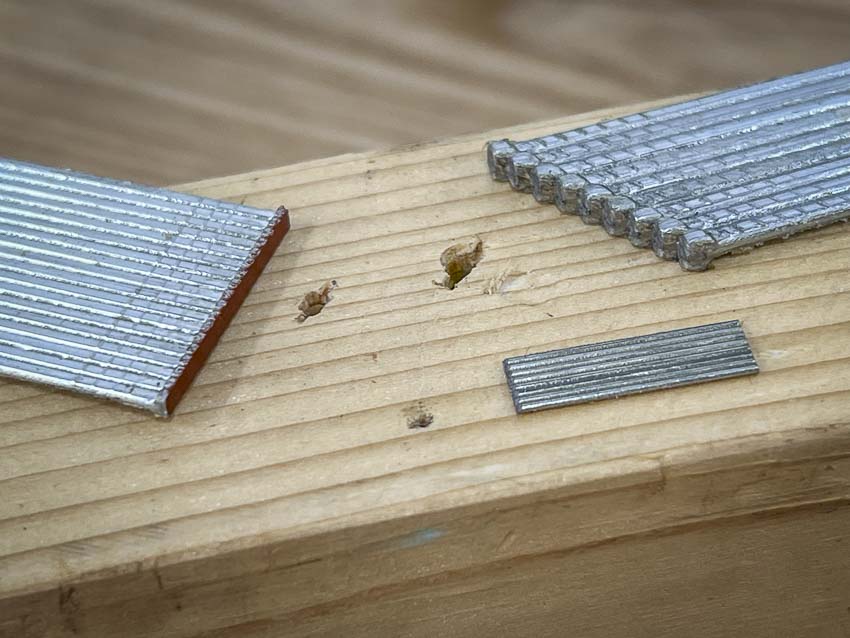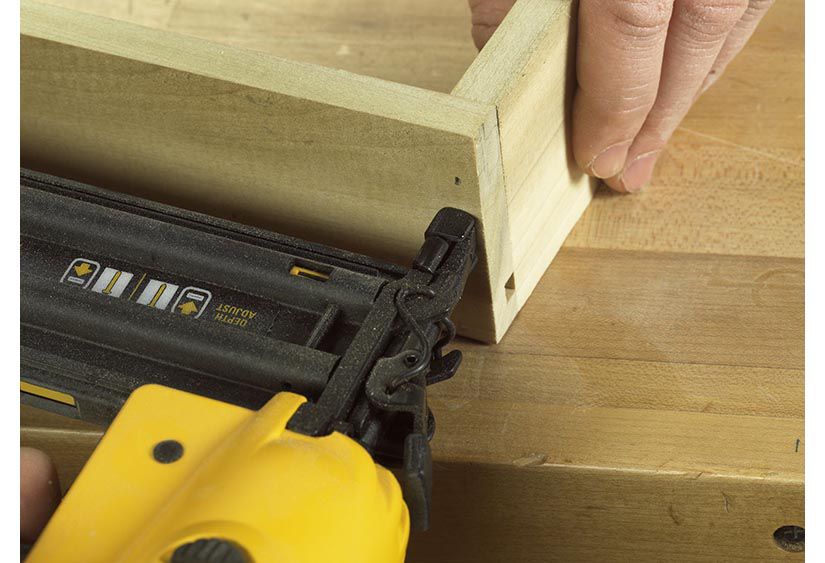Are you curious about the strength of wood glue and brad nails? Wondering how they compare in holding power? Well, you’ve come to the right place! In this article, we’ll explore just how strong wood glue and brad nails can be when it comes to bonding wood together. So, let’s dive in and discover the remarkable strength of these two popular woodworking tools!
When it comes to joining pieces of wood, wood glue is a go-to for many craftsmen. This sticky substance works by creating a strong bond between the wood fibers, providing excellent holding power. But what about brad nails? These slender nails, driven by a brad nailer, offer a different approach to wood joinery. They penetrate the wood and provide mechanical strength. So, which one is stronger? Let’s find out!
In this fascinating exploration, we’ll conduct tests to determine the strength of wood glue and brad nails. We’ll analyze their performance under various conditions, such as different types of wood and stress levels. By the end, you’ll have a clear understanding of just how robust these two woodworking techniques are. So, let’s embark on this captivating journey into the world of wood glue and brad nails!

How Strong is Wood Glue and Brad Nails?
Wood glue and brad nails are commonly used in woodworking projects to hold pieces of wood together securely. But just how strong are these two methods of joining wood? In this article, we will dive into the world of wood glue and brad nails to understand their strength, advantages, and best practices for use.
The Strength of Wood Glue
Wood glue is a popular choice for joining wood due to its high strength and versatility. The strength of wood glue varies depending on the type of glue used and the bonding surface. Most wood glues have a strength rating of around 3,500 PSI (pounds per square inch) when used correctly on wood surfaces.
When applying wood glue, it is important to follow the manufacturer’s instructions for optimal strength. This includes ensuring a clean and properly prepared bonding surface, applying the glue evenly, and allowing sufficient drying time. With proper application, wood glue can create a bond that is often stronger than the wood itself.
Wood glue is particularly effective for joining larger or heavier pieces of wood, such as tabletops or cabinets. It provides a strong and durable bond that can withstand heavy loads and stress. However, it is worth noting that wood glue may not be suitable for certain applications where the wood will be exposed to excessive moisture or outdoor conditions.
The Strength of Brad Nails
Brad nails, also known as finishing nails, are thin and small nails that are commonly used in woodworking projects. While they may not provide the same sheer strength as wood glue, they offer their own set of advantages when it comes to joining wood.
The strength of brad nails depends on various factors, including the length and thickness of the nail, as well as the type of wood being used. Generally, brad nails have a holding strength of around 100 to 150 pounds per inch. This makes them suitable for lightweight or decorative projects, such as attaching trim or securing small pieces of wood.
Brad nails offer the advantage of speed and convenience. They can be driven into wood using a nail gun or a hammer, allowing for quick and efficient assembly. Additionally, brad nails leave smaller holes in the wood compared to other types of nails, resulting in a cleaner and more aesthetically pleasing finish.
Choosing the Right Method for Your Project
When deciding between wood glue and brad nails, it is important to consider the specific requirements of your woodworking project. Both methods have their unique strengths and weaknesses, and the choice often depends on factors such as the type of wood, the weight or load-bearing capacity required, and the desired finish.
For projects that require maximum strength and durability, such as furniture construction or heavy-duty structures, wood glue is generally the better choice. Its high bonding strength and ability to create a seamless bond make it ideal for these applications.
On the other hand, brad nails are a great option for lighter projects or situations where speed and ease of assembly are important. They are commonly used in trim work, paneling, or other situations where a strong but not permanent bond is required.
Best Practices for Using Wood Glue and Brad Nails
Regardless of whether you choose to use wood glue or brad nails, there are some best practices to follow to ensure optimal results:
- Clean and prepare the bonding surfaces: Remove any dirt, dust, or previous finishes from the surfaces to be joined to ensure maximum adhesion.
- Apply the right amount of glue: Use enough wood glue to create a thin and even layer, ensuring that all areas are covered without excess glue squeezing out.
- Clamp the pieces together: To achieve the strongest bond with wood glue, apply pressure by clamping the pieces together until the glue is fully cured.
- Choose the correct size and type of brad nails: Consider the thickness of the wood and the load-bearing requirements when selecting the appropriate size and type of brad nail for your project.
- Use a nail gun or hammer correctly: Follow the manufacturer’s instructions when using a nail gun or hammer to ensure proper insertion and minimize the risk of damaging the wood.
Additional Considerations for Wood Glue and Brad Nails:
Water Resistance: Tips for Outdoor Projects
If you intend to use wood glue or brad nails for outdoor projects exposed to moisture, it is crucial to choose the right type of glue or nails. Look for wood glue that specifically states its water-resistant properties or consider opting for an exterior-grade adhesive. Similarly, when selecting brad nails, choose ones that are coated with materials such as hot-dipped galvanized or stainless steel to prevent rust and corrosion.
Benefits and Drawbacks of Wood Glue
Benefits:
- High bonding strength
- Creates a seamless bond
- Excellent for heavy-duty applications
- Durable and long-lasting
Drawbacks:
- Requires proper surface preparation
- Longer drying time
- Not suitable for all wood types or outdoor projects
Benefits and Drawbacks of Brad Nails
Benefits:
- Quick and easy assembly
- Leaves smaller holes in the wood
- Useful for lightweight or decorative projects
- Convenient for spot repairs or temporary holds
Drawbacks:
- Lower holding strength compared to wood glue
- May require additional reinforcement for heavy loads
- Not suitable for all types of woodworking projects
Conclusion:
Wood glue and brad nails are valuable tools in the woodworking world, providing different strengths and advantages depending on the project at hand. Wood glue offers superior strength and durability, making it ideal for heavy-duty applications, while brad nails excel in lightweight projects that require speed and convenience. By understanding their capabilities and following best practices, you can confidently choose between wood glue and brad nails to create strong and beautiful woodwork.
Key Takeaways: How Strong Is Wood Glue and Brad Nails?
- Wood glue is a strong adhesive that creates a bond by penetrating the wood fibers.
- Brad nails are thin and small, but they provide good holding strength when used properly.
- Combining wood glue and brad nails can create a stronger joint for woodworking projects.
- Wood glue requires sufficient drying time for maximum strength.
- When used together, wood glue and brad nails can withstand normal stress and provide a secure connection in most woodworking applications.
Frequently Asked Questions
Wood glue and brad nails are commonly used in woodworking projects to join pieces of wood together securely. Here are some common questions related to their strength and usage.
1. How does wood glue bond wood pieces together?
Wood glue forms a strong bond between wood pieces by penetrating the wood fibers and then hardening. As the glue dries, it creates a chemical reaction that bonds the pieces of wood together. This bond is often stronger than the wood itself, making it an effective choice for various woodworking applications.
It’s important to apply an even layer of wood glue to both surfaces being joined and firmly press them together. Clamping the pieces together until the glue fully cures ensures a strong bond. Follow the specific instructions provided by the wood glue manufacturer for the best results.
2. Are brad nails as strong as wood glue for joining wood?
While brad nails provide additional reinforcement to the joint, they are not as strong as wood glue alone. The primary purpose of brad nails is to hold the wood pieces together during the glue’s curing process and provide temporary support.
Brad nails are thin and have small heads, which means they do not offer the same level of strength as screws or larger nails. However, when combined with wood glue, they can enhance the overall strength of the joint. It’s important to note that the long-term strength primarily relies on the bond created by the wood glue.
3. Can wood glue and brad nails be used together?
Yes, wood glue and brad nails can be used together to create strong and secure joints in woodworking projects. The wood glue forms a strong, long-lasting bond between the wood pieces, while the brad nails provide additional reinforcement during the drying process.
When using both wood glue and brad nails, it’s important to apply the wood glue evenly, ensure proper clamping, and drive the brad nails into the wood at a 45-degree angle to maximize their holding power. This combination of glue and nails helps create a sturdy and durable joint.
4. How long does wood glue take to dry?
The drying time for wood glue can vary depending on factors such as temperature, humidity, and the type of wood glue used. Generally, most wood glues dry within 30 minutes to an hour, but full curing can take up to 24 hours or longer. It’s important to follow the instructions provided by the wood glue manufacturer for optimal drying and curing times.
During the drying process, it’s crucial to clamp the wood pieces together to ensure a strong bond. Allow sufficient time for the glue to fully cure before applying any stress or load on the joint.
5. Can wood glue be used on all types of wood?
Wood glue is suitable for use on most types of wood, including hardwoods, softwoods, and engineered wood. However, it’s essential to ensure that the wood surfaces are clean, dry, and free from any contaminants that may hinder the bonding process.
Some types of wood, such as oily or resinous woods, may require special formulations of wood glue designed specifically for those types of wood. It is advisable to read the instructions provided by the wood glue manufacturer or consult woodworking experts for guidance on the best glue for the specific type of wood being used.

9 BRAD NAIL MISTAKES (and how to avoid them!)
Summary
Wood glue and brad nails are both strong and widely used in woodworking projects.
Wood glue creates a strong bond between pieces of wood by seeping into the wood fibers.
Brad nails, on the other hand, provide quick and secure fastening, but may not be as strong as wood glue alone.
To achieve maximum strength, it is often recommended to use both wood glue and brad nails together.
Ultimately, the choice between wood glue and brad nails depends on the specific project and personal preference.
